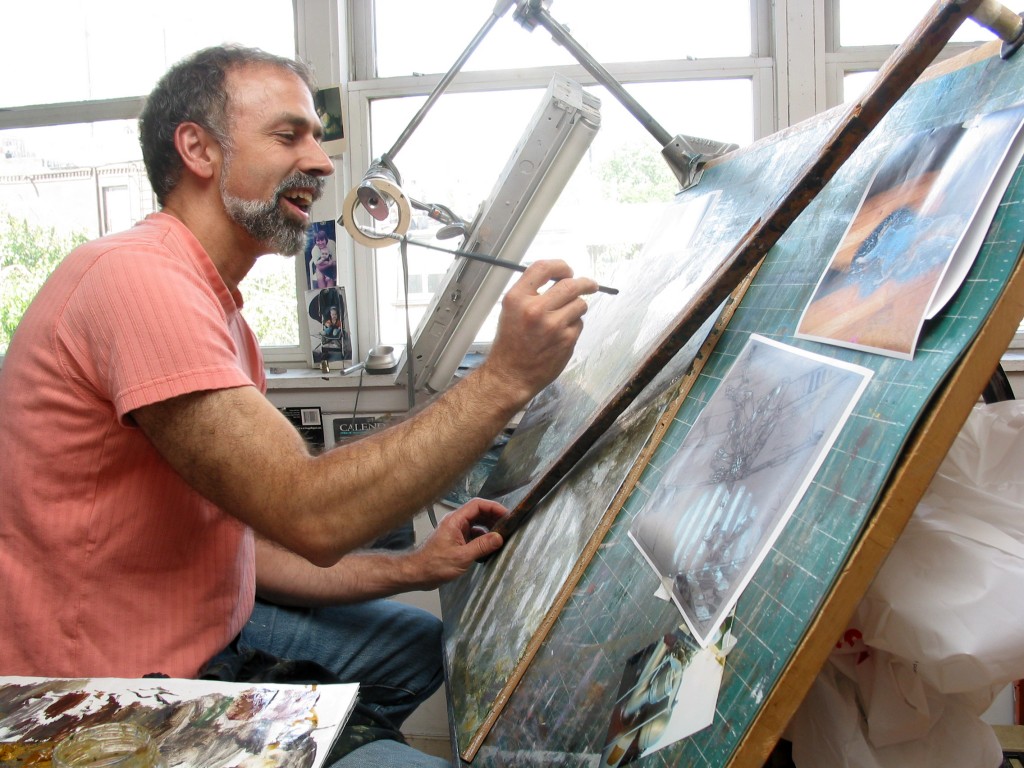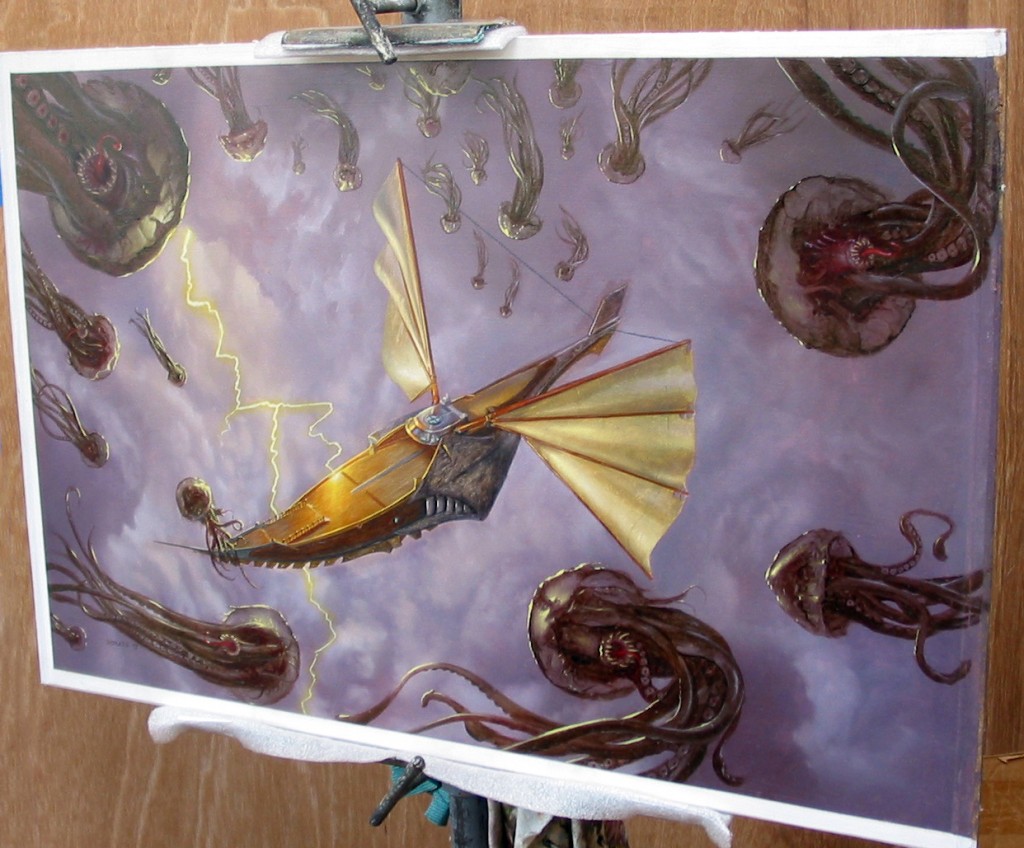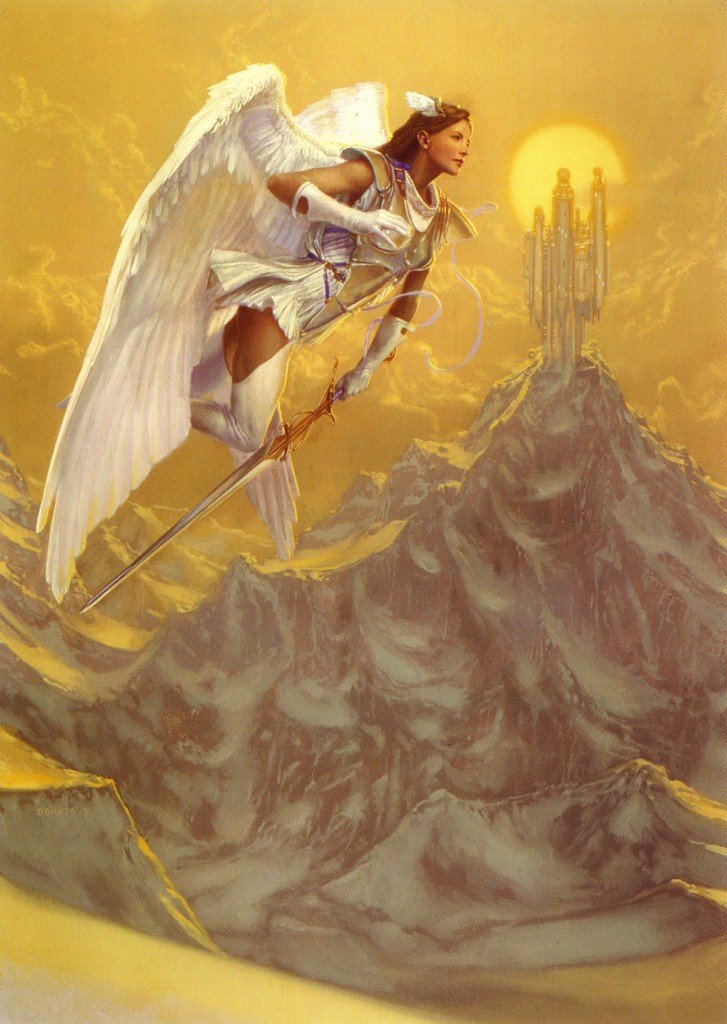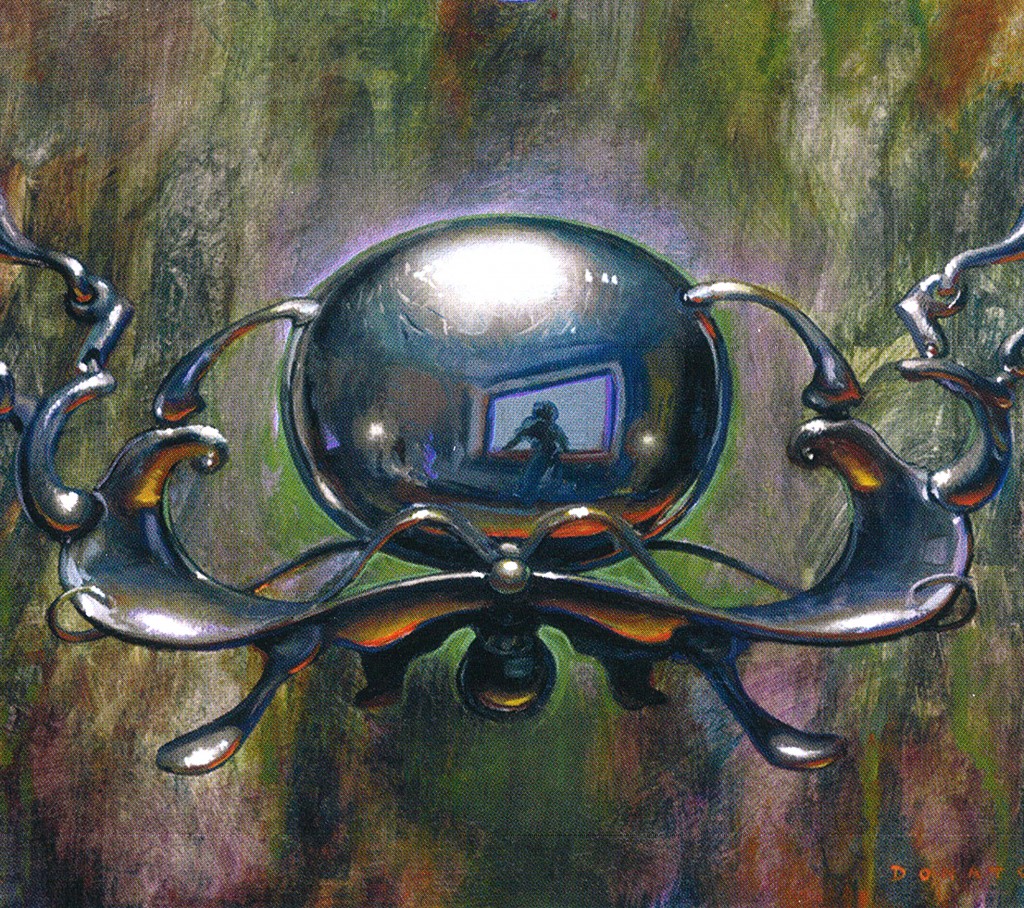An afternoon with Magic: The Gathering artist Donato Giancola
by Patrick Scalisi
On the third floor of a Brooklyn brownstone that he’s occupied for the past 20 years, artist Donato Giancola toils away at his latest painting. In a studio space filled with overstuffed floor-to-ceiling bookcases, a desk of assorted paints and brushes, and every square inch of wall space covered with framed paintings and cutouts, Giancola is working on creating a particularly devious robot — one that may or may not be killing innocent squirrels.

Donato Giancola
“The robot actually is more of a character-holder for humanity, kind of like the technology of humanity’s future,” said Giancola while making fine brushstrokes. “They’re kind of emotionally sympathetic to us as an audience, so you can easily see a person standing in for the robot character. But at the same time since it’s a robot … I don’t have to hang on them a lot of the cultural baggage that I would if I had painted a human.”
On this afternoon on Aug. 5, Giancola is trying to get some work done before attending the opening reception for the Infra:Real exhibit at the Jonathan LeVine Gallery in Chelsea. The exhibit features several of Giancola’s paintings, including one called “Promethean Costs” and another in the robot series called “Breaker.”

In addition to being a fine artist, Giancola is known to legions of Magic: The Gathering fans for illustrating more than 100 cards for the game between the Mirage set in 1996 and Modern Masters in 2014. He is among a constellation of artists that includes Rebecca Guay, Terese Nielsen and Tony DiTerlizzi whose work was brought to Wizards of the Coast during the tenure of then-Art Director Sue Ann Harkey.
“I was going to one of my very first comic book conventions, and my friend introduced me to one of his friends: Bryon Wackwitz. And Bryon had a stream of people at his booth constantly asking for signatures and signings. I was like, ‘How do you have this many people?’” Giancola recalled.
Wackwitz told Giancola about a cool new collectible card game called Magic: The Gathering and suggested that Giancola submit his portfolio to Wizards of the Coast. Shortly thereafter, Giancola received his first commission for Mirage: Amber Prison.
Although the art description for the card simply suggested someone trapped in amber, Giancola wanted to depict a sense of scale, and his final design shows a person who has been miniaturized to roughly the size of a fist. The hint of a ring on the hand holding the amber and the edge of the sleeve further invite the viewer to consider more about the person whose hand is depicted. Who is he? What do the ring and the symbols on his cuff signify?
As a result of that first painting, Giancola quickly earned a reputation at Wizards for creating human hands, which he likens to portrait work. Hands, he said, “are a form of portrait about a character or person. For me, painting a hand is like painting a face. It’s really a statement about that person. It reveals a bit of the history behind that person.”
This also meant that Giancola received a number of artifact commissions, many of which show hands holding wands, axes and orbs, or making arcane gestures.
Giancola is equally fascinated by books and maps, as seen in such cards as Thran Tome, Cartographer and Sisay’s Ring (which features both maps and hands!). He traces this interest back to his love of Dungeons & Dragons, for which he and his friends often made their own maps instead of buying modules/adventures. All of these passions — portraits, hands, maps and books — found their way into his Magic cards.
“When the commissions were really open in the beginning, you could take a lot of that personal passion and interest and inject it into the art,” he said.
These days, Giancola is concentrating on commissions and personal projects — that is, when he’s not playing D&D with his own daughters. A veteran of the publishing industry in addition to his other work, Giancola provided a painting for one of the first edition covers of Patrick Rothfuss’ bestselling fantasy novel The Name of the Wind and did the 2015 Song of Ice and Fire calendar. He’s also doing a mentorship program this fall through the online art education portal SmArt School, which was founded by fellow Magic artist Rebecca Guay.

Archangel (Media Insert Japanese 6th Edition )
Much like his Magic artwork, Giancola’s main goal with his personal projects is storytelling. “I have this desire to tell stories that don’t really quite resolve themselves,” he said. Instead, he likes viewers to come to their own conclusions about what’s going on in the paintings.
“I don’t like to have people walk into these images with assumptions about where they’re going to go,” he added. “I’d rather have them bring their own interpretations.”
Giancola went on to explain that Magic players frequently ask him about what’s going on in the artwork for Chrome Mox and Mirari. Both have indistinct scenes reflected in their chrome surfaces, but Giancola never wrote a “narrative,” so to speak, of what might be happening in the background. It’s all up to the player to decide.
“It’s an artifact, so it’s got to be used by someone. Someone’s got to want it, desire it, maybe want to steal it. So that’s kind of the idea, the way I create the stories around these images,” he said.
As a fellow gamer, Giancola said that he’s extremely thankful for the players’ interest in the artwork and for supporting the artists. He also said that Wizards of the Coast has done a great job of connecting artists and players by ensuring that the art on each card is attributed and by inviting artists to attend large tournaments. In the end, that connectedness has created a network of fans and collectors around the globe.
“Magic really brought a wonderful sense of community to the fantasy marketplace,” Giancola said. “It’s fostered a passion for sharing and coming together over the artwork that almost no other game company has been able to offer.”
Readers can follow Donato Giancola’s art at donatoart.com or facebook.com/donatoart.
Patrick Scalisi is a contributing writer to Art of MtG. After playing Magic: The Gathering as a child during the Fourth Edition era, he resumed again in the summer of 2012. He currently prefers red and white decks.








